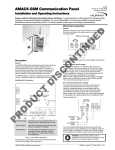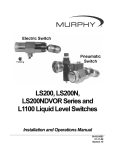Download Murphy EVS-2 Specifications
Transcript
SE C OU he T ck / D A IS va C ila ON bi T lit IN y U ED PH A The Murphy™ EVS Model EX Electronic Vibration Switch Installation and Operations Manual 00-02-2003 06-21-10 Section 20 PH A SE C OU he T ck / D A IS va C ila ON bi T lit IN y U ED In order to consistently bring you the highest quality, full featured products, we reserve the right to change our specifications and designs at any time. The latest version of this manual can be found at www.fwmurphy.com. Please read the following information before installing the EVS. This installation information is intended for all EVS models. A visual inspection of this product before installation for any damage during shipping is recommended. Disconnect all power and be sure machine is inoperative before beginning installation. Installation is to be done only by qualified technician according to the National Electrical Code. Observe all Warnings and Cautions at each section in these instructions. Please contact FW MURPHY immediately if you have any questions. FW MURPHY has made efforts to ensure the reliability of the Electronic Vibration Switch (EVS) and to recommend safe usage practices in system applications. Please note that in any application, operations and device failures can occur. These failures may result in full control outputs or other outputs which may cause damage to or unsafe conditions in the equipment or process connected to the EVS. Good engineering practices, electrical codes, and insurance regulations require that you use independent external protective devices to prevent potentially dangerous or unsafe conditions. Assume that the Murphy EVS system can fail with outputs full on, outputs full off, or that other unexpected conditions can occur. SE C OU he T ck / D A IS va C ila ON bi T lit IN y U ED Table of Contents Table of Contents ....................................................................................................................iii Product Information................................................................................................................ 1 EVS Model EX Overview..............................................................................................1 EVS EX Specifications .................................................................................................2 Installation ............................................................................................................................... 5 Disassembly and Reassembly .....................................................................................5 Mechanical Installation .................................................................................................6 Cabling and Wiring Installation .....................................................................................8 Configuration......................................................................................................................... 13 Setting the Alarm Threshold .......................................................................................13 Setting the Delay Setpoint ..........................................................................................15 Configuring Latching and Non-Latching/Fail-safe and Normal Modes .......................16 Specifications ........................................................................................................................ 18 Environmental ............................................................................................................18 External Power Requirement .....................................................................................18 Frequency Reponse ...................................................................................................18 4-20mA Output (Analog Option) .................................................................................18 Alarm Level ................................................................................................................18 Alarm Trip Time Delay ...............................................................................................18 Output Relay ..............................................................................................................18 LED Outputs...............................................................................................................18 PH A Reset Input .................................................................................................................19 Approvals ...................................................................................................................19 Teflon Tape 1-2-3 Wrapping Technique ............................................................................. 19 SE C OU he T ck / D A IS va C ila ON bi T lit IN y U ED PH A (THIS PAGE INTENTIONALLY LEFT BLANK) Product Information SE C OU he T ck / D A IS va C ila ON bi T lit IN y U ED EVS Model EX Overview The EVS EX is used for high end vibration protection in a low profile, Class 1 Division 1 package. It can be mounted directly to rotating or reciprocating equipment to monitor vibration and activate an on-board relay when a high vibration level is reached. The EX Model uses a piezoelectric crystal and state-of-the-art electronics to provide the highest degree of precision in a stand-alone monitoring system. Stand Alone Switch Both the vibration level and alarm time delay can be set in the EVS EX by adjusting two ports from the front of the switch. The time delay prevents nuisance alarms or shutdowns due to an inadvertent vibration spike. The visual vibration alarm indicator is a bright LED and can be reset either locally or remotely. To provide quick, low cost indication of vibration severity, you can use a basic multi meter to measure the current vibration level. A multi meter can be used to set a precise vibration alarm set point. Preventative Maintenance Tool PH A The EVS EX can also provide vibration trending data via an optional 4-20mA output. This signal can be directed to a local indicator, an engine control or a local control system. Trending data enables the user to plan equipment shutdowns and repairs thereby avoiding catastrophic failures. The combination of the 4-20mA output and the switch provides trending. Section 20 06-21-10 00-02-2003 -1- Features Standard switch with on-board sensor, 1.5 ips SE C OU he T ck / D A IS va C ila ON bi T lit IN y U ED Adjustable set point range and adjustable time delay from 0-10 seconds Relay output Analog option – 4-20mA Output Applications The EVS EX can be used on any equipment where abnormal vibration could lead to equipment damage, including: Cooling towers Reciprocating Compressors Reciprocating Engines Industrial Fans Centrifugal Pumps Motors Gear Boxes Upon detection of abnormal vibration, the operator can decide if there is an obvious problem or if additional troubleshooting is needed. A vibration spectrum analysis can be performed to determine the exact source of abnormal vibrations. EVS EX Specifications The specifications listed are designed to assist in the installation, operation and troubleshooting of the instrument. Service personnel should be familiar with this section before attempting an installation or repair of the instrument. Environmental Temperature: -40° to +85° C (-40° to +185° F) Humidity: 0-95% non-condensing PH A Vibration: 30 g’s max @ 500 Hz External Power Supply Voltage: 20-32 VDC ± 10% Supply Current: 100mA max Frequency Response 6 to 500 Hz, ± 5% on-board sensor version 6 to 1,000 Hz, ± 5%, external sensor version Section 20 06-21-10 00-02-2003 -2- 4-20mA Output (Analog Option) Accuracy ± 5% of full scale at 1.5 ips, 100Hz, 21° C (69.8°F) SE C OU he T ck / D A IS va C ila ON bi T lit IN y U ED 20 mA corresponds to 1.5 or 3.0 ips peak (factory set) Alarm Level Potentiometer for field adjustable alarm level Alarm level range of 0.1-1.5ips Alarm Trip Time Delay Time delay (for actuation) adjustable from 0 to 10 seconds Output Relay Normally Open and Normally Closed outputs Contacts rated 60VDC, 1A and 120VAC, 1A Isolation Voltage (contacts to signal ground): 500VAC Latching/non-latching output user selectable Fail-safe or non-fail-safe operation selected by user LED Outputs Solid – Alarm Mode Solid – Non-Latching mode – LED illuminated if above set point Blinking – Latching Mode – LED blinks if above set point but not yet alarmed Solid Green – Always illuminated with power is ON Reset Input Activated by external N.O. relay or push button contact Reset activation time: 0.5 seconds minimum PH A Reset current < 10mA Approvals UL (Pending) CSA (Pending) Weight 1.75 lbs (.79 kg) Section 20 06-21-10 00-02-2003 -3- PH A SE C OU he T ck / D A IS va C ila ON bi T lit IN y U ED Product Dimensions Section 20 06-21-10 00-02-2003 -4- Installation SE C OU he T ck / D A IS va C ila ON bi T lit IN y U ED Disassembly and Reassembly Always disconnect the power cord before disassembling. WARNING! Failure to disconnect the power before disassembling may cause personal injury and/or property damage. •Make sure that any disassembly is done in a clean, well ventilated, properly controlled static environment. •Always make sure that the assemblies and sub-assemblies are well supported and insulated when doing any repairs on the instrument. •Place small fasteners, connectors and electrical parts in closed containers so as not to lose parts during reassembly. •Read all the disassembly instructions before any disassembly begins. Be sure that you are familiar with the procedures. If any of the instructions for disassembly are unclear, contact Hardy Instruments, Technical Support Department for additional information and assistance. •Do not disconnect any electrical plug, connector or terminal unless an identification tag is present or one is attached. Always note where the connector or plug was attached to the electrical component or wiring harness. •Always install complete hardware groups (Screws, Washers, Lock Washers, Spacers, Etc.) back to the original point of removal. •Always replace broken or damaged modules or hardware immediately! •Always check to be sure that no loose parts are sitting on printed circuit boards or electrical connectors or wires when disassembling or reassembling. •Always protect printed circuit boards from electrostatic discharge (ESD). Always use approved ESD wrist straps and anti-static pads. PH A •Always perform a final inspection after completing any reassembly to be sure that all fasteners are tight, all connectors are secure and there are no loose parts on any of the printed circuit boards in the instrument. •Always follow proper safety procedures when working on or around the instrument. Section 20 06-21-10 00-02-2003 -5- Mechanical Installation SE C OU he T ck / D A IS va C ila ON bi T lit IN y U ED Pre-Installation Requirements Make sure that the surface that you are going to mount the EVS EX to is flat and will fit the hole pattern for the enclosure. If the surface is rough, try to make the surface as smooth as possible. Always install the EVS EX perpendicular to the vibration force being monitored. PH A It is highly recommended that you use flexible conduit or a flexible connector between the rigid conduit and the EVS EX enclosure. A minimum of a 12” flexible connection is recommended. Section 20 06-21-10 00-02-2003 -6- Vertical and Horizontal Installation SE C OU he T ck / D A IS va C ila ON bi T lit IN y U ED 1. Make sure you read the bearing or equipment manufacturers instruction for drilling and tapping equipment casing or housing before installing the EVS EX. 2. Drill and tap four holes for the four (1/4” x 20) bolts that fasten the EVS EX to the equipment casing, bearing housing or mounting plate. 3. Clean the mounting surface making sure there is no debris on the surface. 4. Align the EVS EX over the tapped holes. 5. Place one lock washer and one flat washer on each of the ¼” bolts. 6. It is highly recommended that you apply Loctite® #242 to the bolt threads prior to installation. 7. Screw the bolts into the casing or housing until finger tight. PH A 8. Use a torque wrench and tighten each bolt to a minimum of 70 inch pounds. Torque requirements may vary depending on the material you are attaching the EVS EX to. Vertical Installation Section 20 06-21-10 Horizontal Installation 00-02-2003 -7- Cabling and Wiring Installation SE C OU he T ck / D A IS va C ila ON bi T lit IN y U ED Standard EVS S-EX and Analog EVS-A-EX 1. Remove the top cover from the EVS-EX. 2. Place a slotted screw driver in the slot of the 8 pin connector. Pry the screw driver away from the back of the connector until the connector comes loose from the header. PH A 3. Lift the connector off the header Section 20 06-21-10 00-02-2003 -8- SE C OU he T ck / D A IS va C ila ON bi T lit IN y U ED 4. Put the power cable through the bottom 3/4” NPT opening. (See Teflon Wrapping Technique at the end of this document.) 5. Connect the power cable wires as indicated in the pin out diagrams shown below. Pin out for Standard Switch PH A Pin out for Analog Option 6. Put the relay wires through the side ¾” NPT opening. Section 20 06-21-10 00-02-2003 -9- 7. Connect the relay wires according to the pin out diagrams above. 8. Reconnect the 8-pin connector by pushing it onto the header until it snaps into place. SE C OU he T ck / D A IS va C ila ON bi T lit IN y U ED 9. Thread the conduit connectors into the EVS EX housing until snug. PH A 10. Screw on the top cover until snug. Section 20 06-21-10 00-02-2003 - 10 - External Standard Accelerometer Wiring SE C OU he T ck / D A IS va C ila ON bi T lit IN y U ED 1. Remove the EVS EX top cover. 2. Connect the Power and Relay wires per instructions above. 3. Place a slotted screw driver in the slot of the 3-pin connector. Pry the screw driver away from the back of the connector until the connector comes loose from the header. 4. Lift the connector off the header. 5. Connect the external accelerometer wires as indicated in the pin out diagram below. PH A Standard External Accelerometer Wiring Section 20 06-21-10 00-02-2003 - 11 - 6. Reconnect the 3-pin connector by pushing it onto the header until it snaps into place. 7. Thread the conduit connectors into the EVS EX housing until snug. SE C OU he T ck / D A IS va C ila ON bi T lit IN y U ED 8. Screw in the top cover until snug. External Charge Accelerometer Wiring 1. Remove the EVS EX top cover. 2. Connect the Power and Relay wires per instructions above. 3. Feed the Coaxial cable that leads from the Charge accelerometer through the bottom ¾” NPT opening. 4. You will have to wrap the coaxial cable around the inside diameter of the EVS EX in order to thread the cable connector onto the header. The internal surfaces of the EVS switch enclosure are smooth so there is no fear that the coaxial cable can be damaged. 5. Screw the coaxial connector onto the header. 6. Thread the conduit connectors into the EVS EX housing until snug. PH A 7. Screw in the top cover until snug. Section 20 06-21-10 00-02-2003 - 12 - SE C OU he T ck / D A IS va C ila ON bi T lit IN y U ED Configuration Setting the Alarm Threshold WARNING! Always adjust the IPS alarm threshold to meet your specific alarm requirements in the environment the machinery is in. Setting the alarm threshold too high can result in property damage and/or personal injury. 1. Use a small Phillips or slotted head screw driver to adjust the Alarm Threshold IPS setting. 2. If you know the threshold setting you want, set the adjustment to rotating the potentiometer clockwise or counter clockwise until the indicator is pointing at the correct Alarm Threshold. PH A Clockwise – Increases the IPS alarm setting Counter Clockwise – Decreases the IPS alarm setting Each hash mark on the potentiometer equals 0.1 IPS Range – 0.1 to 1.5 Section 20 06-21-10 00-02-2003 - 13 - 3. If you are setting your vibration alarm as a function of the baseline (or a multiple of the baseline), first establish the baseline as follows: SE C OU he T ck / D A IS va C ila ON bi T lit IN y U ED Adjust the time delay to the maximum level of 10 seconds. Use a slotted narrow head screw driver and turn the pot clockwise until the indicator is pointing to 1.5 IPS. Starting with the Alarm Setting at the 1.5 IPS, turn the alarm potentiometer counter clockwise until the Alarm LED begins to flash, thus indicating that the threshold has been reached. This establishes your alarm baseline. Rotate the Alarm Potentiometer clockwise to the desired level. This can be done in Latching or Non-Latching mode. Measured Alarm Threshold Setup 1. If you need a more accurate setting, use a voltmeter and place the probes on the TP1 test point and TP2 test point. 2. 1 IPS = 1 Volt PH A 3. While reading the voltmeter, adjust the alarm threshold pot to the requirements for your application. Section 20 06-21-10 00-02-2003 - 14 - Setting the Delay Setpoint SE C OU he T ck / D A IS va C ila ON bi T lit IN y U ED WARNING! Always adjust the Delay to meet your specific requirements. Too long a delay can result in property damage and/or personal injury. 1. To adjust the Delay setpoint use a slotted narrow head screw driver. 2. Put the screw driver through the adjustment port and into the slot on the top of the delay potentiometer. 3. To increase the delay setting turn the pot clockwise Each hash mark on the overlay equals 1 second Range – 1 to 10 seconds PH A 4. To decrease the Delay setting turn the pot counter clockwise. Section 20 06-21-10 00-02-2003 - 15 - Configuring Latching and Non-Latching/Fail-safe and Normal Modes SE C OU he T ck / D A IS va C ila ON bi T lit IN y U ED The alarm relays can be configured to operate in a latching or non-latching mode, Fail-safe or Normal mode. Latching Mode – When an alarm or shutdown condition is reached, the output remains in the alarm condition until it is reset. Non-Latching Mode – The output is automatically reset when the alarm condition no longer exists. Fail-safe Mode – Should a loss of power occur, when in fail-safe mode the switch reverses the relay settings. Normal Mode – In Normal mode when a power loss occurs, the relays remain in the states indicated in the diagram below. Normal does not reverse the relay settings. PH A NOTE: To differentiate between the “Failsafe” and “Normal” settings on the switch plate, the teal colored settings indicate failsafe and black settings indicate normal. Section 20 06-21-10 00-02-2003 - 16 - SE C OU he T ck / D A IS va C ila ON bi T lit IN y U ED The dip switch indicator allows you to select one of four modes by moving the black rectangles to indicate the state of the switch. These modes are illustrated in the following switch configuration examples. Fail-Safe / Latching Mode Fail-Safe / Non-Latching Mode Normal / Non-Latching Mode PH A Normal / Latching Mode Section 20 06-21-10 00-02-2003 - 17 - Specifications SE C OU he T ck / D A IS va C ila ON bi T lit IN y U ED Environmental Temperature: -40° and +85°C (-40° and +185°F) Humidity: 0-95% non-condensing Vibration: 30 g’s max @ 500 Hz External Power Requirement Supply Voltage: 20 - 32 VDC ± 10% Supply Current: 100mA Max Frequency Response 6 to 500 Hz, ±5%, on-board sensor version 6 to 1,000 Hz, ±5%, external sensor version 4-20mA Output (Analog Option) Accuracy ±5% of full scale at 1.5 ips, 100Hz, 21° C (69.8° F) Alarm Level Potentiometer for field adjustable alarm level Alarm level range of 0.1-1.5ips Alarm Trip Time Delay Time delay (for actuation) adjustable from 0-10 seconds Output Relay Normally-Open and Normally Closed outputs Contacts rated 60VDC, 1A and 120VAC, 1A Isolation Voltage (contacts to signal ground): 500VAC Latching/non-latching output user selectable PH A Fail-safe or non-fail-safe operation selected by user LED Outputs Solid – Alarm Mode Solid – Non-Latching mode – LED illuminated if above set point Blinking – Latching Mode – LED blinks if above set point but not yet alarmed Solid Green – Always illuminated when power is ON. Section 20 06-21-10 00-02-2003 - 18 - Reset Input Activated by external N.O. relay or push button contact SE C OU he T ck / D A IS va C ila ON bi T lit IN y U ED Reset activation time: 0.5 seconds minimum Reset current < 10mA Approvals UL (Pending) CSA (Pending) Teflon Tape 1-2-3 Wrapping Technique The biggest reason for leaks via the conduit into electrical devices is often improper wrapping of the Teflon tape on the threads. Here’s a simple 1-2-3 technique that might help. Caution: Your hands and the fitting should be clean of any debris or dirt. 1. Hold the Teflon tape roll in your left hand and the fitting in your right. PH A 2. Place the tape on top of the threads, one thread back from the starting thread, holding it down with your thumb. Roll the fitting in a clockwise direction, stretching the tape slightly as you wrap, overlapping each turn to cover completely. Section 20 06-21-10 00-02-2003 - 19 - PH A SE C OU he T ck / D A IS va C ila ON bi T lit IN y U ED 3. Wrap the Teflon tape (3) times around the fitting, hold down on the threads with your thumb, and pull on the tape roll to 'cut' the tape. Don’t allow the tape to fray. You now have a properly wrapped fitting ready for use. Install the fitting hand tight, and then give it up to two turns with a wrench. If it wants to stop before two turns, DO NOT force the fitting. You can damage the threads or destroy the seal. Do not back off on a tightened fitting or it might leak. Section 20 06-21-10 00-02-2003 - 20 -

































